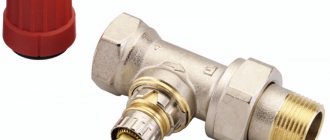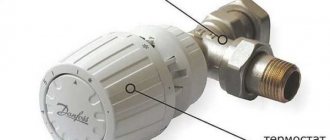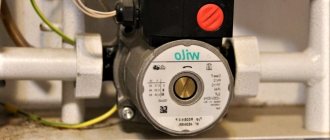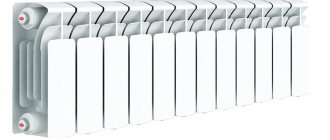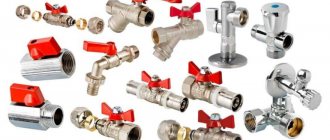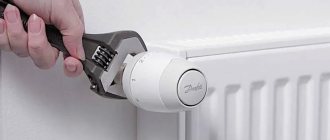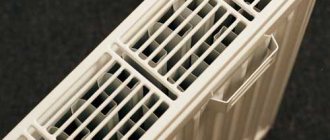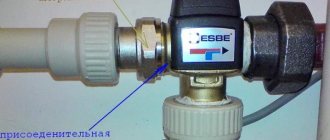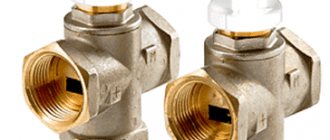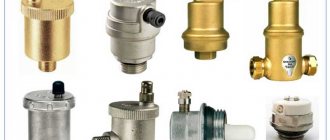Here you will learn:
- Purpose of the thermal valve
- Advantages and disadvantages
- Characteristics of thermal valves
- Valve operating principle
- Types of devices
- How to choose
- How to install correctly
- Rules for adjusting the operation of the device
- Expert advice
The thermostatic valve for a heating radiator provides regulation of the amount of coolant flowing through the radiator. Adjustment can be done either manually or automatically. This valve saves heating costs.
Purpose of the thermal valve
The valve solves two problems: maintains the room temperature at a comfortable level and saves energy.
But in order for it to really cope with such functions, you need to understand in what cases the device is appropriate and how to install it correctly.
If in the middle of winter there is a need to open the windows so that the temperature in the room drops to an acceptable level, a thermostat is definitely needed. But it won’t help when the radiators are barely warm—it will probably make it even colder.
In the second case, it is better to try to regulate the temperature in the room differently: change the volume of coolant in each radiator, adjust the operation of the boiler (for a large area), select the optimal circulation pump or adjust the operation of the existing one.
The price of a thermostat ranges from several hundred rubles (200-600), so re-equipment of the heating system will not be expensive. But there are also expensive models
As a temporary measure, control valves can be used. But it is not recommended to use ball valves for these purposes.
Changing operating modes of heated floors
The thermostat is an effective solution for monitoring the water temperature in the heating circuit. This method is inexpensive and accessible to almost every owner. The boiler heats the water to 90 degrees, and water should flow to the floors at a temperature twice as low.
The desired degree can be achieved thanks to the thermostatic head:
- The supply of hot water is short-term - the water fills the pipeline, the supply ends until it cools to an acceptable temperature;
- Constant water supply with the addition of cool coolant from the return pipe.
Periodic short-term supply
With a short-term water supply, the system works in a small space - a bathroom, ceramic floor in the toilet, shower room and other places. At the supply point there is a valve with two strokes, a remote-type floor sensor and a thermal head.
Advantages and disadvantages
The advantages of installing thermostatic valves in the heating system include the following factors:
- Energy independence of the device.
- Compactness.
- High precision temperature control.
- Easy to operate and highly reliable.
- Aesthetic appearance.
- The optimal combination of price and functionality.
The disadvantages of using thermostatic valves are:
- Difficulty setting up.
- There is a danger of the thermal head malfunctioning under the influence of a draft or a nearby stove.
Types of thermostatic valves for radiators
Thermostatic valves operate in manual or automatic mode.
In the first case, the user changes the radiator temperature level by turning the control head. In the second, the heating value is set using marks on the device. Further adjustment occurs automatically. Types of thermostatic valves for radiators:
- For single pipe systems. They have a large throughput capacity, up to 5.1 m3/hour. Installation in open heating circuits is allowed.
- For two-pipe systems. The most common type of valves is selected according to technical parameters, checking them with the characteristics of the heat supply.
- Three-way. Mounted together with a bypass, they perform the functions of distributing heat flow in the system.
- With the possibility of hydraulic adjustment.
- With connection to an external thermometer.
The valves differ in the installation method - angular, axial. The choice affects the method of connection to the radiator, where the inlet and outlet pipes are located. It is possible to install an additional shut-off valve, one or two pipe circuits. This will optimize the operation of the heat supply and increase safety.
Characteristics of thermal valves
For your information, here are a number of basic technical characteristics of thermostatic valves:
- The maximum operating pressure level is 1.0 MPa.
- Pressure testing before commissioning is 1.5 MPa.
- The maximum operating temperature is +110 ºС.
- The maximum permissible ambient temperature is +50 ºС.
- The valve capacity is from 1.6 to 2.5 m³/h.
- Temperature control range - +20…+60 ºС.
- Response time: 25 min.
- MTBF with manual control - 8000 cycles.
What materials are they made from?
Corrosion-resistant metals are used to make the thermostatic valve body:
- Brass.
- Bronze.
- Stainless steel.
Additionally, the surfaces of brass products are nickel-plated, and the bronze body is either also nickel-plated or coated with a layer of chrome.
Budget elements with fixed water temperature
In simple heating systems of country houses that receive thermal energy from a TT boiler, it is allowed to install a three-way valve of a simplified type that operates autonomously. To operate, it does not need a thermal head with a temperature sensor, and there is no rod there. The control thermostatic element is installed inside the housing and is set to a certain outlet water temperature, for example, 60 or 50 °C (indicated on the housing).
Operating diagram and design of a valve with a built-in control element
A thermal mixing valve of this type always maintains a fixed temperature of the coolant at the outlet; this setting cannot be changed. This gives rise to the pros and cons of using such fittings:
- The advantage is a lower price than the cost of a unit with a thermal head. The difference is significant - about 30%.
- Disadvantage - it is impossible to regulate the heating of the exiting coolant. When the element is set at 55°C from the factory, it will always supply water at this temperature ±2°C.
Advice. Before purchasing a valve of a simplified design, carefully read the technical documentation for the solid fuel boiler; it often indicates the minimum temperature of the return coolant. You will find more information on the use of mixing fittings in a separate publication.
Valve operating principle
The valve with thermal head is designed to maintain the set temperature in offline mode. The device operates on the principle of compression-expansion of gas or liquid depending on the environment. The thermostat can be built-in or located remotely.
The thermostatic valve has a bellows - a corrugated movable container that is filled with a heat-sensitive agent. When the surrounding air heats up, the agent increases in volume and puts pressure on the valve's shut-off cone, initiating its closure. When cooling, the reverse process occurs - the agent cools, the bellows decreases in volume and the valve opens.
There are gas and liquid bellows. Gas agents are more sensitive to environmental changes, but are more expensive and more difficult to produce. Liquid ones are less sensitive, but cheaper. The difference in temperature control accuracy is about 0.5 degrees, which is not significant.
Kinds
According to the method of transmitting the signal to the thermal element, it can come from the coolant, indoor air. The valve of different types can be almost identical. They will differ in the thermal head. Today, all existing varieties can be divided into 2 types: mechanical and electronic. Devices have their own characteristics, which affect their performance characteristics.
The devices differ not only in the type of material, but also in the installation method. They can be of angular or straight (pass-through) type, depending on the type of connection. For example, if the main is connected to the side, a direct type valve is installed. The corner method is used when connecting from below. The valve option is chosen to be the one that fits best into the system.
The choice between them depends on the preferences of the buyer and his financial capabilities. Products can be designed for a specific type of thermoelement. To understand the differences between thermostats, you need to briefly note their main nuances.
Mechanical
Mechanical thermostats are easy to use, precise and consistent in use. They do not need a network connection. Manual products are different from their electronic counterparts. They work on the principle of a regular faucet: the regulator is turned in the desired direction, allowing the required amount of coolant to flow through. The devices are cheap, but not the most convenient, since to change the heat transfer you need to manually turn the valve each time.
If you install them instead of ball valves, you can use any of them to adjust. The devices are technologically advanced and do not require preventive maintenance. However, often there are no markings at the inlet and outlet of radiators of this design to adjust the heating temperature. Almost always you have to set it experimentally.
Before installing such structures, it is necessary to adjust them, as well as install hydraulic resistance. Smooth adjustment is carried out due to the throttle mechanism, which is located inside the device. This can be done on one of the valves (inlet or return). The operation of a mechanical thermostat depends on the hot and cold points inside the room, as well as the direction of air movement in the room. Another disadvantage is the fact that they react to the operation of household appliances with their own thermal circuits (for example, refrigerators, electric heaters, and hot water pipes).
Electronic
Such modifications are more complex in design compared to manual analogues. With their help you can make your heating system flexible. They not only allow for temperature control of an individual radiator, but also provide control of the main components of the system, including the pump and mixers. Depending on the model, programmable devices are equipped with different types of sensors.
The electronic mechanism can measure the ambient temperature of a specific space (the place where it is installed). Using the software, the received data is analyzed and a decision is made to reduce or increase the temperature. Such a mechanism can be analog or digital. The digital version has 2 modifications: its logic can be open or closed.
The difference between the categories is that products with closed logic are not able to change the functioning algorithm. They remember the level of the initially set temperature and maintain it. Analogs of open logic are able to independently select the desired control program. However, they are rarely used in domestic conditions, since it will be difficult for the average buyer to initially program them, selecting the desired options from the many built-in functions.
Types of devices
Today there are several types of thermostatic valves. Among them the most popular are:
- Mechanical. They require manual adjustment of the coolant supply.
- Semi-electronic. They are controlled by a special thermal head with a bellows device.
- Electronic. Control is carried out using a remote temperature sensor.
Mechanical thermostats
The main advantages of mechanical structures are low price, smooth and precise functioning, and ease of use. During their operation, you do not need to use auxiliary energy sources. Thanks to their modification, it is possible to manually regulate the volume of coolant entering the radiator, controlling its heat transfer. In such devices you can accurately set the degree of heating.
The main disadvantage of mechanical equipment is the lack of markings for adjustment, so its adjustment is carried out mainly by trial and error. The product consists of:
- a bellows filled with a liquid or gaseous mixture;
- regulator;
- drive.
The main role is played by the substance with which the bellows is filled. When the position of the thermostat lever changes, it enters the spool, adjusting the rod. The latter, under such influence, blocks the passage, thereby limiting the entry of coolant into the radiator.
Electronic temperature sensors
Electronic devices are more complex, because they are based on a programmable microprocessor. Thanks to it, it becomes possible to set the required temperature in the room. To do this you need to press several buttons. There are multifunctional models with which you can control a mixer, boiler or pump.
The operating principle and design of electronic units are almost no different from mechanical products. Inside such equipment there is a substance that reacts to temperature changes. As the temperature increases, it expands and pressure is generated, under the influence of which the rod begins to move, automatically closing the valve. As the temperature decreases, the substance contracts, causing the valve to open.
The bellows has high strength and a long service life. The substance can withstand repeated compression throughout its entire operational period of several decades. There are the following types of electronic designs:
- Closed valves for heating batteries cannot automatically determine the temperature value, so they are adjusted manually. You can set the temperature values, as well as their permissible fluctuations.
- Open products that can be programmed. So, when the temperature decreases, the operating mode changes. In addition, it is possible to adjust the timer and configure the operation of certain modes. In most cases, such designs are in demand on an industrial scale.
Electronic products operate using batteries or a rechargeable battery sold complete with a charger. Semi-electronic valves are an ideal option for home use. They are equipped with a digital display that shows the temperature in the room.
Gas and liquid valves
When operating the regulator, gaseous or liquid substances can be used as a temperature control element. Because of this, all devices are divided into liquid and gas.
The latter have a long service life (at least 20 years). This is due to the fact that gaseous substances contribute to a clearer and smoother regulation of temperature in the room. The products are equipped with a sensor that detects temperature. The gas bellows reacts faster to temperature changes in the room.
Fluid devices more accurately transmit internal pressure to driving mechanisms. When choosing a product, most consumers focus on the service life and quality of the product. There are several types of structures:
- remote;
- having a built-in sensor.
The latter are often installed horizontally. This is due to the fact that they need air circulation around them. It is advisable to use remote units in the following situations:
- with a vertically located thermostat;
- when heating equipment is located at a distance of less than 10 and more than 22 cm from the window sill;
- the radiator is covered with thick curtains;
- battery depth is more than 16 cm;
- The radiator is located in a niche.
In such situations, the built-in thermostat will not function correctly, so most often a remote one is used. Most often, sensors are placed at right angles to the body. When installed in parallel, their values will be lost under the influence of the heat emanating from the battery.
Why is it necessary to regulate heat flow in a heating system?
When drawing up a home heating project, it is necessary to perform a heat calculation, thanks to which the optimal equipment performance, mains power and thermal balance throughout the house are selected. During operation, the mode may change due to many reasons:
- change in outside temperature;
- solar Activity;
- gusts of wind;
- thermal radiation from household appliances.
As a result, the calculated temperature balance is disrupted. But you cannot remove or plug individual sections of heating batteries. To eliminate this situation, it is necessary to install additional elements with the help of which the temperature of the coolant is regulated.
The advantages of a three-way mixing valve include:
- simple installation;
- long service life;
- functional features;
- practicality;
- the ability to independently change the temperature of the liquid.
Among the negative aspects, it is necessary to highlight: high cost and inability to operate with contaminated flows
How to choose
The thermostat is selected according to the operating characteristics of the heating system. The device must:
- Withstand pressure in the range of 16–40 bar and temperatures up to 200 °C.
- Be made of corrosion-resistant materials that are resistant to mechanical stress.
- Match the diameter with the size of the pipeline.
- Match the thread parameters on the pipe.
Popular manufacturers
Thermostats manufactured by the following companies are considered the most reliable and durable:
- Danfoss (Denmark). Devices from this manufacturer, despite their fairly low price, have an improved design. They are equipped with a flow stabilizer, so they operate silently. They do not become clogged when working with any contaminated coolant, since their rod stroke is 1.5 times greater, and the performance adjustment window has a larger cross-section.
- Oventrop (Germany). The variety of standard sizes of thermostatic fittings from Oventrop allows you to choose the ideal model for any engineering system. Excellent regulating qualities, high product reliability are combined with an aesthetic appearance.
- Luxor (Italy). Luxor thermostats are suitable for heating systems where the coolant is hot water. They are equipped with a thermostatic spindle that allows pre-setting of the flow.
Rules for drawing up a heating scheme with natural circulation
Knowing the basic principles of operation of a heat supply system with natural circulation and choosing the optimal scheme, you can begin to assemble it. This stage is no less important than the previous ones, since further heating operation will depend on the technical parameters of the components.
Heating pipes
It is necessary to take into account all the features of this system. In schemes with forced circulation, compensation of hydraulic losses occurs due to the operation of the circulation pump. For systems with natural circulation in closed heating, such a mechanism does not exist
Therefore, to minimize losses, you should pay attention to the following points in the design and selection of components:
- Heating pipes. Their diameter should be from DN32 to DN40. This compensates for the friction of water on the inner surface. It is also recommended to choose polymer products with a smooth wall. Their actual outer diameter is from 40 to 50 mm;
- Highway routing diagram. It is necessary to avoid rotating units that increase hydraulic resistance in the system;
- Height of the accelerating riser. In a heating scheme for a two-story house with natural circulation, it should be higher than the ceiling of the second floor. The expansion tank is located in the attic;
- Characteristics of shut-off valves. Its presence should not affect the system parameters.
To better understand the operating principles of the heating circuit of a two-story house with natural circulation, an analogy can be drawn with well-known communicating vessels. In this case, the boiler will be located below the level of the radiators, therefore the liquid flow will circulate in its direction. That is why when developing a diagram and installing a heating system with natural circulation, it must be located as low as possible.
To prevent changes in water flow, a special valve is installed on the return pipe. This phenomenon may occur when the system is first started, when the difference in coolant temperatures is small.
How to install correctly
They install a thermostat for a heating radiator at the inlet or outlet of the heating device - there is no difference, they work with equal success in both positions. How to choose a place to install?
According to the recommended installation height. There is such a clause in the technical specifications. Each device is configured at the factory - they are calibrated to control the temperature at a certain height and usually this is the upper radiator manifold. In this case, the heat regulator is installed at a height of 60-80 cm; it is convenient to adjust it manually if necessary.
Installation diagrams for heat regulators for radiators
If you have a bottom saddle connection (pipes fit only from the bottom), there are three options - look for a device that can be installed at the bottom, install a model with a remote sensor, or reconfigure the thermal head. The procedure is simple; the description must be in the passport. All you need is to have a thermometer and at certain moments turn the head in one direction, then in the other direction.
Installation is standard - on fum tape or linen winding with packaging paste
The installation process itself is standard. The valve has a thread. The appropriate fittings are selected for it or a matching thread is cut on the metal pipe.
One important point that those who want to install a thermostat for a heating radiator in apartment buildings should remember. If you have a single-pipe installation, they can only be installed if there is a bypass - a section of pipe that stands in front of the battery and connects the two pipes to each other.
If you have a similar wiring (there may not be a pipe on the right), a bypass is required. The thermostat should be installed immediately behind the radiator
Otherwise, you will regulate the entire riser, which your neighbors will definitely not like. For such a violation, a very substantial fine can be issued. Therefore, it is better to install a bypass (if not).
Price overview
Before you go to a retail outlet to purchase a three-way tap, you need to clarify all the technical points regarding the mixer and heating line. In addition, you can use our advice and look at reviews of manufacturers.
We offer an overview of trusted manufacturers and the estimated cost of fittings:
- Swedish offers faucets from RUB 3,900;
- "Honeywell" offers convenient and simple three-way valves for heating with a thermostat at a price of 5,500 rubles;
- Valtec entered the market not so long ago, but the products have proven themselves only on the positive side. Cranes can be purchased at a price of 3,500 rubles;
- offers mixers at prices starting from 3,550 rubles;
- Heimer products can be called leaders in the budget line. They can be bought from 2,000 rubles.
Three-way valve "Heimer"
Rules for adjusting the operation of the device
After installation, you need to adjust the operation of the device. To do this, we first close the windows and doors - we insulate the room to prevent heat leakage.
Then we proceed like this:
- We turn on the heating.
- We set the valve to the position of maximum heat transfer and measure the temperature.
- We are waiting for the room temperature to rise by 5 degrees and become constant.
- Close the valve and wait for a comfortable temperature.
- Then we open the thermostat a little bit until we hear the sound of passing water. The body of the device itself should become warmer.
- The last point needs to be remembered.
In a private home, air must be bleed from the batteries before adjustment. In this case, maximum care must be taken to avoid the release of hot steam.
When more than three batteries are connected to the boiler, each thermostat must be opened to a different level so that the heat is distributed evenly throughout the rooms
The adjustment starts from the coldest room. It needs to be warmed up well before moving on to other rooms.
Video about installation
You can learn how to install a thermostatic mixing valve by watching the video below.
When installing thermostatic equipment, it is important not only how it will be installed, but also where. Incorrect installation can completely damage the heating system. Proper connection will ensure a comfortable microclimate in the room and the required temperature in the water supply system. In addition, such equipment is capable of regulating the pressure in the system. A thermostatic valve is simply necessary for heating and water supply in an apartment or private house.
Source
Expert advice
A few tips from professionals will help the apartment owner install and configure the thermostatic valve with his own hands and in accordance with all the rules:
- It is important to mount the device in such a way that the direction of water movement coincides with the direction shown by the arrow shown next to the marking on the body, otherwise the operation of the thermostatic valve will be incorrect.
- For underfloor heating systems, it is better to choose thermostats with a side valve - this makes settings easier to access.
- In public areas, thermostatic valves with remote control or pre-setting should be used for installation to protect them from outside influence.
- To seal the threaded connection, you should not use fum tape, but polymer or linen threads with heat-resistant paint. When heated and significant temperature changes occur, thermal expansion of the pipes occurs, the density of the tape may be disrupted, which will lead to the formation of a leak.
- It is more appropriate to place the valve on the supply pipe.
- The distance from the floor to the installation site of the thermostatic valve should be at least 40-60 cm. Initially, manufacturers configure them to capture temperature changes at this level. If it is necessary to change this parameter, then additional configuration of the device is performed.
- The thermostatic head must be installed on the valve in a horizontal position and turned towards the inside of the room. If you install the thermal head vertically, the warm air from the riser will interfere with the normal operation of the sensor.
- When installing a thermostatic valve in a one-pipe heating system, it is necessary to install an additional bypass section - a bypass. It should be located between the sections of pipelines entering the heating device and leaving it (as in the photo below).
Connection features
Methods for connecting radiators
When installing heating systems in private homes, the following connection methods are used:
In this case, the supply pipe is connected from above, and the return pipe is connected from below to the same section. This connection diagram for the heating battery allows the radiator to heat up evenly. However, if the accordion has a large number of sections, then significant heat loss will occur, so it is better to use other connection options.
Saddle and bottom
This method is an excellent option for cases where pipes run through the floor. The connection is made to the pipes located at the bottom of the structure, in opposite sections. The only disadvantage of this method is its low efficiency, since heat loss can reach 15 percent.
Used when connecting devices with a large number of sections. As you might guess, the inlet pipe in this case is connected from above, and the outlet pipe from below, in the opposite section. This scheme for connecting heating radiators in a private house promotes uniform distribution of coolant and maximum heat transfer from appliances.
Note! When using a thermostat for heating parallel to the radiator, a bypass must be installed. This will allow you to regulate the degree of heating of the device.
Radiator connection diagram
As we can see, the methods for connecting heating radiators depend on a number of factors, such as the method of laying pipes, the power of the equipment, etc. In particular, the type of system is of great importance. We will talk in more detail about the types of heating systems below.
Single-pipe system diagram
Types of system
When installing heating systems, two schemes are used:
- Single-pipe - is the simplest, since the coolant circulates through one pipe, to which heating devices are connected in series. Its disadvantage is that it does not allow you to regulate the heat supply. Therefore, heat transfer corresponds to the design norm laid down during the design. This scheme is used in small systems, since with a long pipeline and a large number of radiators, the devices will heat up unevenly.
- Double-pipe - its meaning is that hot water flows through one pipe, and cooled water returns to the boiler through the other. In this case, heating batteries are connected in a private house, respectively, in parallel. The advantage of such a device is the uniform heating of the sections, as well as the ability to adjust the heat transfer. The only drawbacks that can be identified are the need for more pipes; accordingly, the cost of the structure increases.
Diagram of a two-pipe system
It should be noted that, regardless of the type of system, connecting heating batteries with your own hands can be done in two ways:
- According to the vertical scheme, the heating device is connected to a vertical riser, from which wiring is carried out to the radiators.
- According to the horizontal scheme, the coolant circulates through horizontal pipelines.
The choice of heating battery connection diagram depends on the characteristics of the house. For example, if the housing contains several floors, then the connection is realized according to a vertical scheme.
In the photo there is a radiator located under the window
